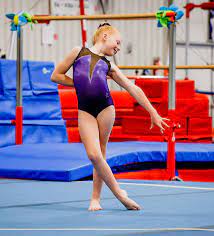Young children develop motor skills rapidly in their early years—and gymnastics for kids is one of the most effective, fun, and engaging ways to support this growth. It encourages physical literacy, improves coordination, and builds strength through structured movement and play.
From walking along balance beams to performing forward rolls, gymnastics offers a perfect mix of gross and fine motor challenges. This article breaks down how this sport supports a child’s motor development, with practical insights for parents who want to help their children grow with confidence and control.
Why Are Motor Skills So Important for Young Kids?
Motor skills are the foundation for almost every activity a child does—running, writing, catching a ball, or climbing stairs. They fall into two categories:
- Gross motor skills – large muscle movements like crawling, jumping, or throwing.
- Fine motor skills – smaller movements involving coordination, like picking up small objects or using scissors.
Strong motor skills lead to improved balance, body control, hand-eye coordination, and overall physical confidence. They also support cognitive and social development by enabling kids to explore their environment, interact with others, and complete everyday tasks.
How Does Gymnastics Support Gross Motor Development?
Gymnastics is built on dynamic, whole-body movement. From the very first warm-up, kids are engaging multiple muscle groups and spatial awareness skills. Here’s how:
1. Balance and Coordination
Using beams, mats, and climbing structures helps kids master balance. Whether walking across a low beam or holding a pose on one leg, they learn to stabilise their bodies in motion.
2. Jumping and Landing Techniques
Vaulting and floor exercises teach controlled jumping, soft landings, and directional changes—critical components of safe gross motor progression.
3. Strength and Endurance
Repetitive drills like bear crawls or rope climbs develop core strength, leg power, and upper body endurance. Strong muscles support posture and injury prevention.
Can Gymnastics Improve Fine Motor Skills Too?
Absolutely—though often less obvious, gymnastics helps develop fine motor precision through:
- Grip control – Holding bars, rings, or ropes strengthens hand and finger muscles.
- Finger and wrist coordination – Chalk application, adjusting gear, and equipment interaction all require fine control.
- Concentration and timing – Kids learn when to release, grab, twist, or rotate—a synchronisation of mind and micro-movement.
These skills are transferable to classroom activities like writing, drawing, or using cutlery.
What Makes Gymnastics Especially Effective for Kids?
Unlike team sports or solo activities, gymnastics for kids blends instruction with imagination. Coaches guide children through structured routines while allowing space for exploration and creativity. This is critical for:
Repetition with Variation
Motor learning relies on repeating tasks—but not in a boring way. Gymnastics uses obstacle courses, themed routines, and rotating equipment setups to keep sessions fun yet consistent.
Whole-Brain Engagement
Motor skills aren’t just physical—they’re neurological. Sequencing movements, remembering routines, and adjusting to balance challenges all activate a child’s brain and body together.
Positive Reinforcement
Using encouragement, praise, and achievable challenges taps into the principle of Liking (Cialdini), making kids more likely to enjoy and stick with the activity. Enjoyment builds habit—and habits build skill.
At What Age Should Kids Start Gymnastics?
Children as young as 18 months can start participating in movement-based classes. These early sessions focus on exploration, parent-child bonding, and building confidence on soft equipment.
By ages 3 to 5, kids begin learning basic shapes (like tucks and straddles), improving listening skills, and following simple instructions. These are prime years for developing body awareness and motor patterns that will carry through school years and beyond.
Are There Risks to Watch Out For?
Like any physical activity, gymnastics carries small risks—most of which can be avoided through:
- Supervised classes with certified instructors
- Age-appropriate equipment and exercises
- Emphasis on proper technique before progressing
- Encouraging rest and avoiding overtraining
Structured programs focus on safe skill-building and often include injury prevention protocols. When properly managed, gymnastics is one of the safest youth sports in Australia.
Key Benefits of Gymnastics for Kids’ Motor Development
Here’s a quick summary of what your child gains:
- Improved balance, flexibility, and body awareness
- Stronger core, arms, and legs
- Better hand-eye coordination and spatial skills
- Confidence to explore new movements
- Foundation for lifelong physical activity
Frequently Asked Questions
What if my child isn’t naturally athletic?
That’s okay! Gymnastics builds coordination and confidence gradually. Many programs are non-competitive and focus on individual progress.
How often should my child attend gymnastics?
Most kids benefit from 1–2 sessions per week, with time for rest and recovery between classes.
Can gymnastics help with focus and behaviour?
Yes. Structured routines, listening to instructors, and turn-taking improve attention span and discipline in young children.
Conclusion
Gymnastics isn’t just about flips and cartwheels—it’s a full-body developmental tool. By supporting both gross and fine motor skills, gymnastics for kids lays the foundation for physical competence, confidence, and lifelong movement habits.
To explore programs that nurture these skills from an early age, consider enrolling in a kids gymnastics program.
For more on how motor development impacts learning outcomes, see this article from Raising Children Network.

